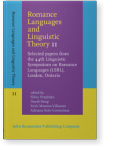Chapter 1
Embedding verbs and subjunctive mood
The emotive factor
I give a uniform account of French mood from a semantic and nano-syntactic perspective by revising the criteria for the distribution of indicative vs. subjunctive mood. I claim that the subjunctive is selected by the semantic property of emotivity encoded in the main clause verb. I develop a definition and a syntactic representation of emotive vs. non-emotive verbs and a set of diagnostics for the two classes. I also reexamine the notion of veridicality and show that it is not the determining factor in the choice of mood (contra Giannakidou 1998, 2009, a.o.).
Article outline
- 1.Introduction
- 2.Theoretical background
- 2.1Nanosyntax (Starke 2009, 2011; Caha 2009)
- 2.2Veridicality, non-veridicality, and relative veridicality
-
3.Personal constructions
- 3.1Decomposing the meaning(s) of verbs
- 3.2
Dowty (1991)
- 3.3Emotive vs. non-emotive sentience
- 3.4Verbs optionally taking indicative or subjunctive CPs: Emotive vs. non-emotive readings
- 4.Impersonal constructions
- 5.The proposal
- 5.1The structures of personal constructions
- 5.2The structures of impersonal constructions
- 6.Conclusion
-
Acknowledgements
-
Notes
-
References
References (31)
References
Baunaz, Lena. 2015. On the various sizes of complementizers. Probus 27 (2): 193–236. 

Baunaz, Lena. 2016. Deconstructing complementizers in Serbo-Croatian, Modern Greek and Bulgarian. Proceedings of NELS 46 (1): 69–77.
Baunaz, Lena, and Genoveva Puskás. 2014. “The Selection of French Mood.” In Selected Papers from the 41th LSRL, Ottawa, May 2011, ed. Eric Mathieu et Marie-Hélène Côté, 233–253. John Benjamins.
Baunaz, Lena, and Eric Lander. Under review. Nanosyntax: the basics. Ms. Universiteit Gent.
Becker, Martin G. 2010. “Principles of mood change in evaluative contexts: the case of French.” In Modality and mood in Romance, ed. by Martin G. Becker and Eva-Maria Remberger, 209–234. Berlin: de Gruyter. 

Caha, Pavel. 2009. The nanosyntax of case. PhD, University of Tromsø
Cinque, Guglielmo. 1999. Adverbs and Functional Heads. Oxford: OUP.
Costantini, Francesco. 2009. Interface Perspectives on Clausal Complementation. The Case of Subjunctive Obviation. Venezia, Libreria Editrice Cafoscarina.
Dowty, David. 1991. “Thematic Proto-Roles and Argument Selection”, Language 67: 547–619. 

Egré, Paul. 2008. Question-Embedding and Factivity. Grazer Philosophische Studien 77 (1): 85–125. 

Ernst, Thomas. 2002. The syntax of adjuncts. Cambridge: CUP.
Giannakidou, Anastasia. 2009. The dependency of the subjunctive revisited: temporal semantics and polarity. Lingua, special issue on Mood, 883–1908.
Kelepouris, Stavros. 2012. The syntax and semantics of subject-oriented adverbs. A proposal for a new classification. Ms. University of Ghent.
Kiparsky, Paul, and Carol Kiparsky. 1971. “Fact.” In Semantics: An interdisciplinary reader in philosophy, linguistics and psychology, ed. by Danny D. Steinberg and Leon A. Jakobovits, 345–369. CUP.
Kratzer, Angelika. 2013. Modality and the semantics of embedding, slides from presentation at the Amsterdam Colloquium, December 2013.
Léger, Catherine. 2006. La complémentation de type phrastique des adjectifs en français. PhD, Université du Québec à Montréal.
Moulton, Keir. 2009. Natural Selection and the Syntax of Clausal Complementation, Doctoral dissertation, University of Massachusetts Amherst.
Puskás, Genoveva. 2013. Subjunctives – a Family Business. Talk given at the Séminaire de Recherche, University of Geneva, 16.09.2013.
Quer, Josep. 2009. Twists of mood: The distribution and interpretation of indicative and subjunctive. Lingua 119 (12): 1779–1787. 

Ramchand, Gillian. 2008a. Verb Meaning and the Lexicon. CUP. 

Ramchand, Gillian. 2008b. Lexical Items in Complex Predications: Selection as Underassociation. Nordlyd, Tromsø Working Papers in Linguistics.
Rizzi, Luigi. 1997. “The fine structure of the left periphery.” In Elements of grammar: A Handbook of Generative Syntax, ed. by Liliane Haegeman, 281–337. Dordrecht: Kluwer. 

Rosch, Eleanor H. 1973. Natural categories, in Cognitive Psychology 4: 328–50. 

Ruwet, Nicolas. 1984.
Je veux partir / *Je veux que je parte: on the Distribution of Finite Complements and Infinitival Complements in French. In Cahiers de Grammaire 7: 75–138.
Socanac, Tomislav. 2011. Subjunctive in Serbian/Croatian. GG@G 7: 49–70.
Starke, Michal. 2009. “Nanosyntax. A short primer to a new approach to language.” In Nordlyd 36.1, special issue on Nanosyntax, ed. by Peter Svenonius, Gillian Ramchand, Michal Starke, and Knut Tarald Taraldsen, 1–6. CASTL, Tromsø.
Starke, Michal. 2011. Towards an elegant solution to language variation: Variation reduces to the seize of lexically stored trees. Ms. Barcelona, Spain.
Tóth, Enikő. 2008. Mood Choice in Complement Clauses. Frankfurt: Peter Lang.
Villalta, Elisabeth. 2006. Context dependence in the interpretation of questions and subjunctives. PhD dissertation, Universität Tübingen
Cited by (1)
Cited by one other publication
This list is based on CrossRef data as of 16 july 2024. Please note that it may not be complete. Sources presented here have been supplied by the respective publishers.
Any errors therein should be reported to them.
